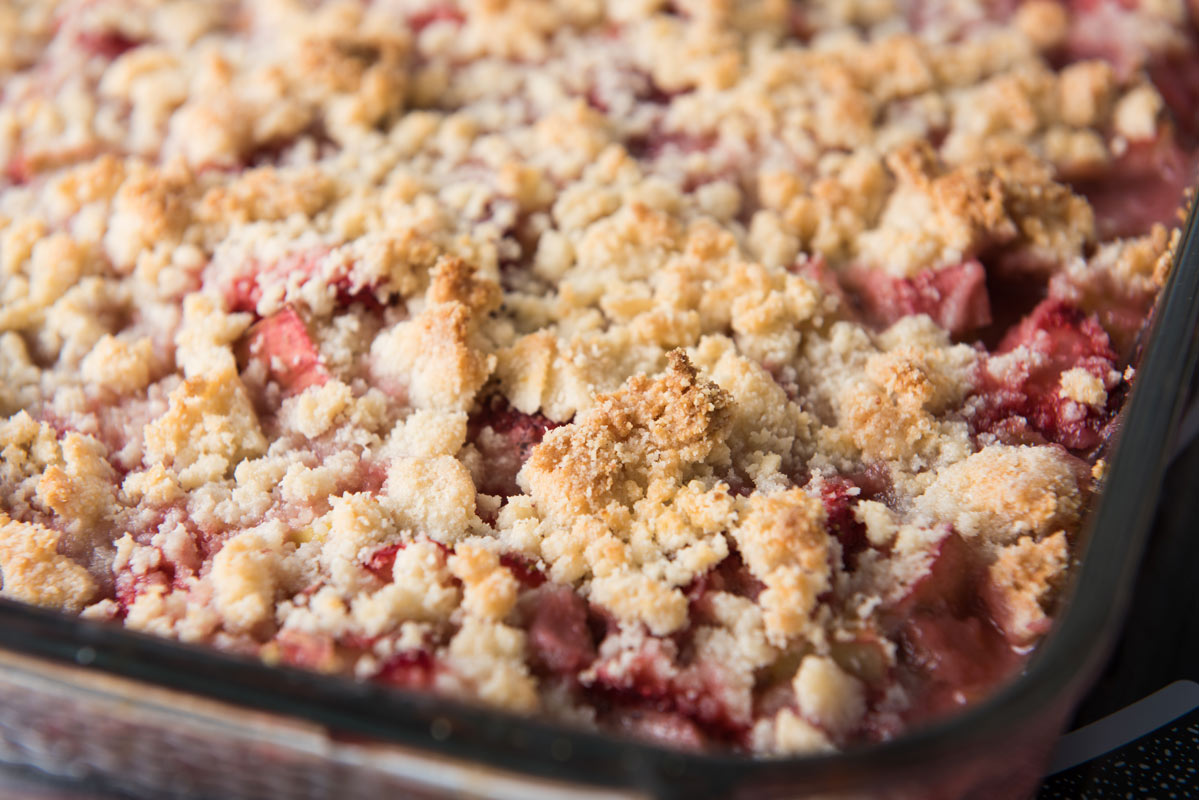Mixed Berry Buckle Recipe, Spotlight on Blackberries, Pastry Cutters, Vitamin D Needs Vary and How Incentives Help You Move More
Whether you’re hosting a 4th of July party or need a dish to bring to a celebration, berry buckle checks all the boxes. It has the essential red, white, and blue look, thanks to its abundance of berries, can be made early in the day (or even the night before), and travels with ease if it’s to bring to a BBQ or picnic. While such outdoor activities can offer a boost of vitamin D, a new research review points out that how much you need is very individualized, and a one-size-fits-all approach to taking supplements probably isn’t effective for everyone. Need more motivation than being in sunshine to move more? Another study I’m sharing found that incentives can really make a difference.
Mixed Berry Buckle
 Mixed Berry Buckle
Mixed Berry BuckleWhen it comes to cobblers versus cakes, a buckle is the best of both worlds—a rich batter heavily studded with fresh fruit and topped with a crunchy crumble. As it bakes, the batter rises, or buckles, over the berries as the crumble crisps and browns. This version uses three berries for a red, white, and blue theme (the cake itself counts as the “white”!). The following proportions are for a large cake that will feed a crowd or provide delicious leftovers for breakfast the next day.
Ingredients
For the crumble topping:
- 4 ounces unsalted butter, cubed and chilled
- 1 cup granulated sugar
- 2/3 cup flour
- 1/2 teaspoon ground cinnamon
For the cake:
- 1/2 cup extra virgin olive oil, plus more for the baking dish
- 2-1/2 cups all-purpose flour
- 1/2 cup whole wheat pastry flour
- 1 teaspoon fine sea salt
- 1-1/2 teaspoons baking powder
- 8 ounces unsalted butter at room temperature
- 2 cups granulated sugar
- 8 large eggs
- 6 cups assorted berries, such as blueberries, blackberries, and sliced strawberries
Directions
Step 1
Make the topping: Use your hands or a pastry blender to turn the butter, sugar, flour, and cinnamon into small bits, ranging from the size of peas to beans. Set aside.
Step 2
Preheat your oven to 350°F. Lightly coat a 13-inch by 9-inch baking dish with olive oil; set aside. To make the batter, in a medium bowl, whisk together the flours, salt, and baking powder. In a large bowl or standing mixer, cream butter and sugar until fluffy. Add eggs, one at a time, beating after each addition to combine, then add the olive oil and briefly beat again. Gradually add to the wet ingredients, mixing just until incorporated.
Step 3
Transfer the batter to your baking dish and use a large offset spatula to smooth the top. Arrange the berries evenly over the top, being sure to get some into the corners of the dish. Crumble the topping evenly over the fruit.
Step 4
Bake until the tip of a sharp knife inserted in the center of the cake comes out clean, about an hour. Serve while still warm.
Yields 12 servings

Healthy Ingredient Spotlight
Blackberries

Plump, deep-purple blackberries are the unsung heroes of the berry patch. So sweet when ripe, they’re packed with vitamins C, K, and E, fiber (8 grams per cup), and a bounty of health-boosting phytochemicals, including anthocyanin, which gives them their unique color. Like blueberries, they hold their shape well when baked. Look for them at your farmers’ market or try growing them yourself.

Quick Kitchen Nugget
Pastry Cutters

Also called a dough or pastry blender, a pastry cutter is a handy tool for cutting butter into flour thanks to its stainless steel blades. When making crumble and streusel toppings as well as pastry dough, it can be easier on your hands than using your fingers for the job, especially if you choose a style with an ergonomic cushioned nonslip handle. You simply press down with the pastry cutter, then lift and repeat, moving around your bowl until you get pieces the size that you need.

For Your Best Health
Vitamin D Needs Vary
A new study from scientists at Trinity College Dublin, published in the journal Clinical Nutrition, sheds light on the complexities of achieving optimal vitamin D status for different population groups, a mystery that is becoming increasingly important to unravel because the incidence of vitamin D deficiency remains high. More than helping to build strong bones, vitamin D regulates many cellular functions in your body, according to the Mayo Clinic. It has anti-inflammatory, antioxidant, and neuroprotective properties that boost your immune health, your brain cell activity, and how well your muscles function.
The authors analyzed data from half a million participants from the UK and calculated an individualized estimate of each person’s ambient ultraviolet-B (UVB) level, which is the wavelength of sunlight that induces vitamin D synthesis in the skin.
Their comprehensive analysis revealed novel insights. The first is that ambient UVB is a critical predictor of vitamin D status, even in a place like the UK, which receives relatively little sunlight. The second is that your age, sex, BMI, cholesterol level, and vitamin D supplementation significantly influence how you respond to UVB. For example, when BMI and age increase, the amount of vitamin D produced in response to UVB decreases.
“We hope this work can highlight the significant differences in vitamin D levels among different ethnic groups at northern latitudes and contribute to efforts to address the long-standing population health issue of vitamin D deficiency,” said study first author Dr. Margaret M. Brennan, research assistant in the department of public health and primary care in the School of Medicine at Trinity College.
Principal investigator Dr. Lina Zgaga, associate professor of epidemiology at Trinity, added, “We believe our findings have significant implications for the development of tailored recommendations for vitamin D supplementation. Our study underscores the need to move away from a one-size-fits-all approach towards personalized strategies for optimizing vitamin D status.”
Talk to your doctor about assessing your vitamin D status and what you might need to do to boost it.

Fitness Flash
Incentives Help You Move More
Adults with heart disease risks who received daily reminders or incentives to become more active increased their daily steps by more than 1,500 after a year, and many were still sticking with their new habit six months later, according to a study supported by the National Institutes of Health (NIH) published in the journal Circulation.
The improvements, which also resulted in an extra 40 minutes of moderate exercise each week, correlated with a 6% reduced risk of premature death and a 10% reduced risk of cardiovascular-related death, compared to data from prior studies. As a reminder, the Department of Health and Human Services recommends that most adults should get at least 150 minutes of moderate aerobic exercise per week, such as brisk walking, or 75 minutes of vigorous exercise, like fast cycling, or a combination of the two, paired with twice-weekly strength sessions.
Researchers found that while a simple daily reminder was effective in helping people move more, offering financial incentives or point-based rewards from playing a game was even more effective…and combining the two incentives was the most effective. Participants who got both were still logging improvements in activity levels six months after the rewards stopped.
“Even moderate exercise can drastically reduce cardiovascular risk, so finding low-cost ways to get people moving and stay[ing] in a fitness program that they can do at home is a huge win for public health,” said Alison Brown, PhD, RD, a program officer at the National Heart, Lung, and Blood Institute, part of NIH.
The study took place between 2019 and 2024. Researchers followed more than 1,000 adults at elevated risk for major cardiovascular events. All participants received a wearable fitness tracker, which connected to an online health portal and enabled researchers to count their baseline daily step count. Participants then set a goal to increase their daily steps by 33%, 40%, 50%, or any amount greater than 1,500 steps from their starting point. (Before the study began, participants in all groups logged an average of about 5,000 daily steps, or 2.4 miles.)
After they set their goals, participants were randomly placed into one of four groups. People in three of the groups were offered incentives: game-like rewards, financial rewards, or a combination of the two. The fourth group was the control group; participants received no incentives but got the fitness tracker, along with daily messages that noted their step count.
In the game group, each participant received points every week and kept them by meeting their daily step goals. On days they failed to meet their goals they lost points. Participants with enough points moved up a level, and participants who failed to meet goals moved down a level. A family member or friend could act as a participant’s “support crew” and receive weekly updates about their progress. At the end of the study, adults who reached the highest levels by meeting their daily step goals received trophies. In the financial group, each participant received $14 each week, but lost $2 a day if they did not meet their step targets. The third group received both game-like and financial incentives.
Compared to the control group, the game-incentive group walked an extra 538 steps per day from their baseline amount, while those who received financial incentives walked an extra 492. The group who received both incentives averaged 868 extra steps and maintained an average of 576 more daily steps six months later.
“The interventions created immediate benefits for participants, and they worked,” said Alexander C. Fanaroff, MD, one of the study authors, an expert in behavior change, and an interventional cardiologist and assistant professor of medicine in the division of cardiology at the University of Pennsylvania in Philadelphia. “Research shows it’s easier to think about today instead of the future, whether it’s exercising more to support long-term heart health or saving for a future goal, like college or retirement.”
Researchers said people wanting to change their behavior, especially around exercise, can focus on the same principles used in the study, which created immediate benefits or rewards for movement. For example, there are exercise apps that provide daily reminders and rewards for meeting personal health goals, or people could enlist family and friends for support, and even create scenarios where they lose money by giving it away if they don’t meet their targets.
Get More Recipes In Your Inbox!